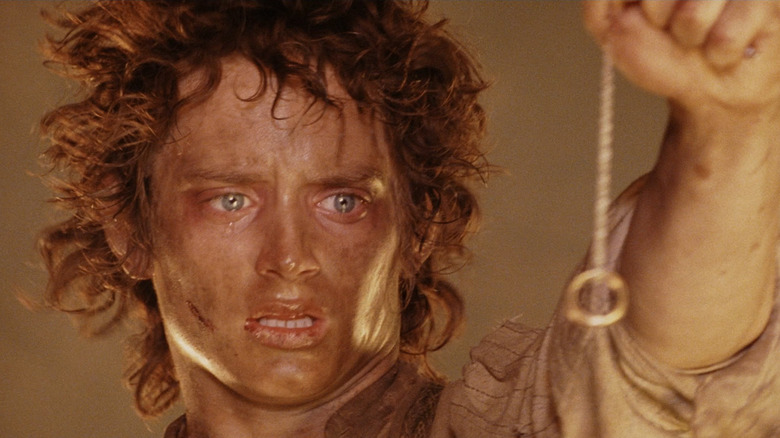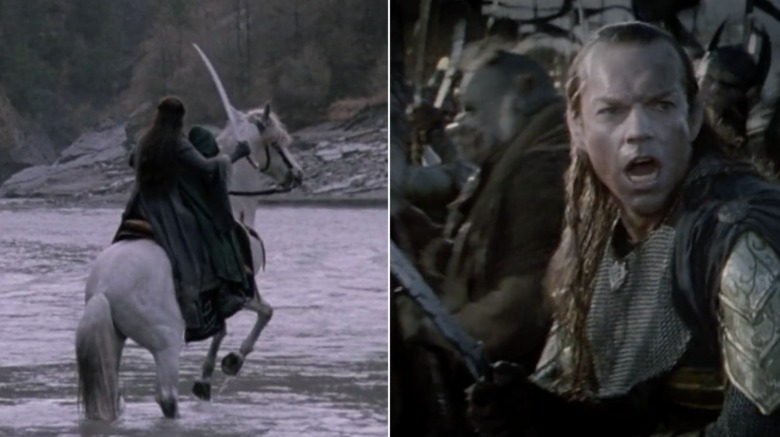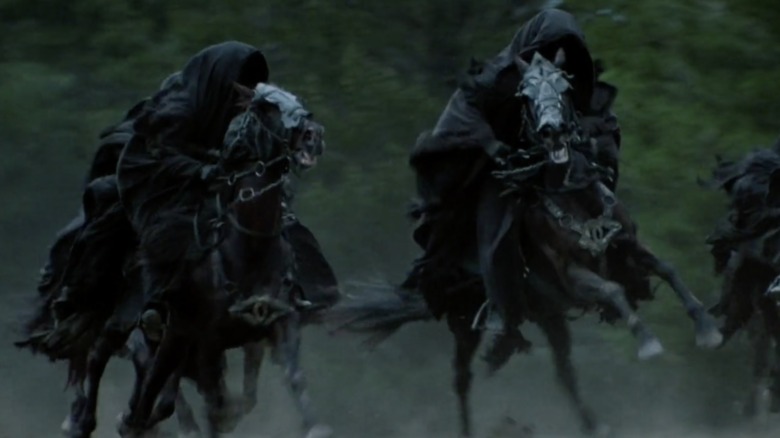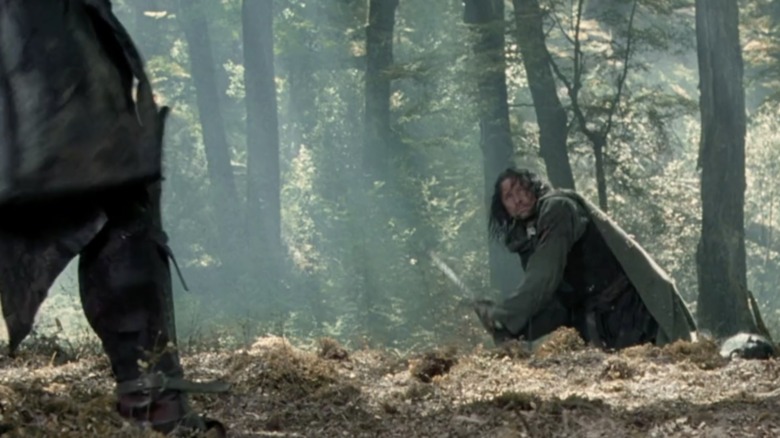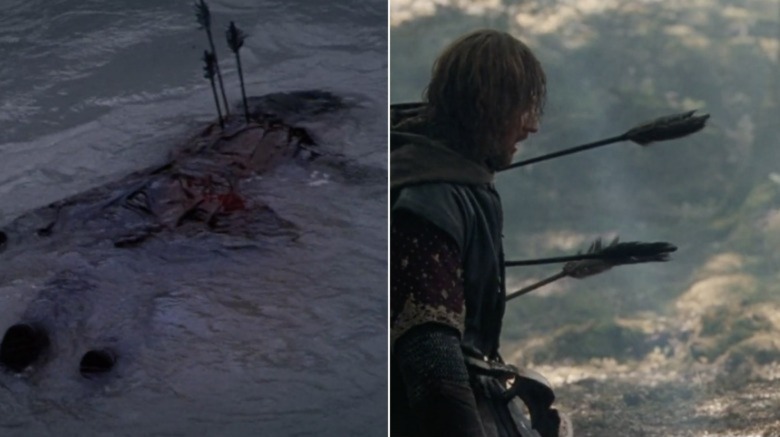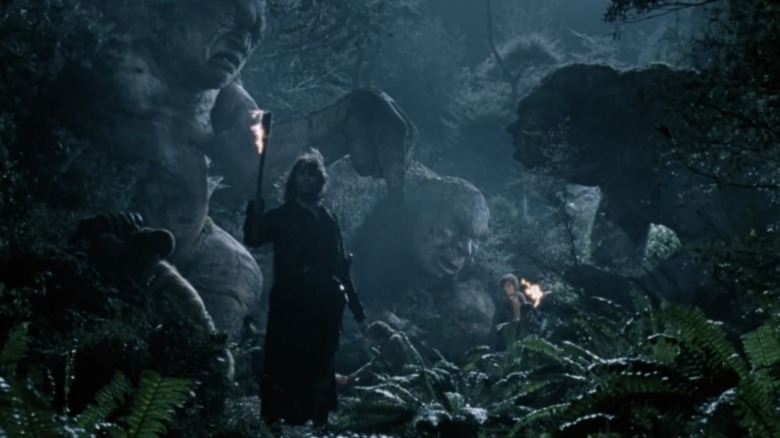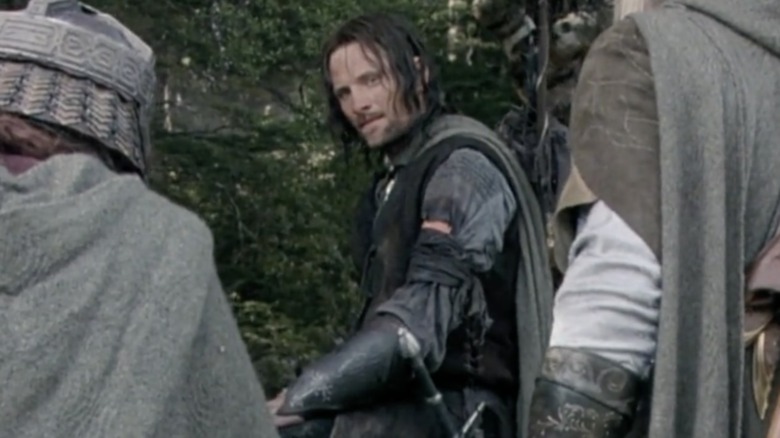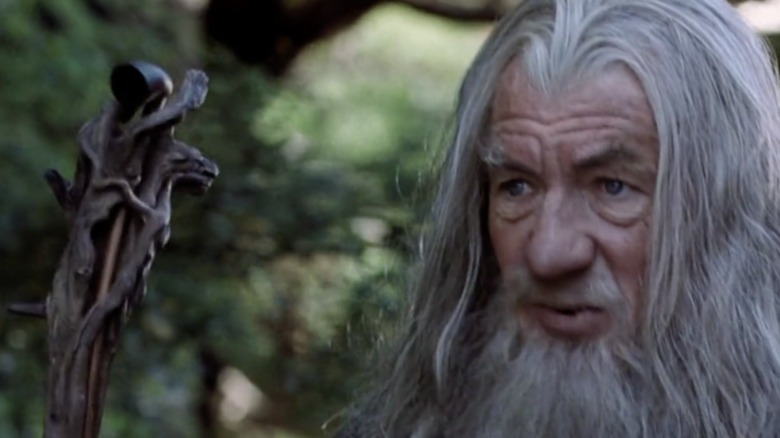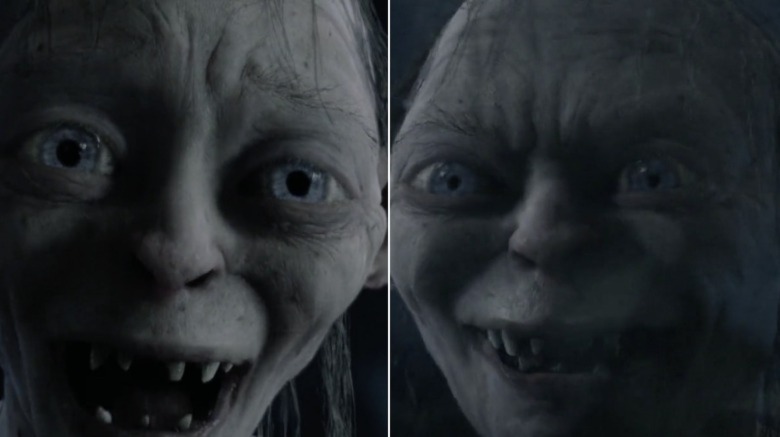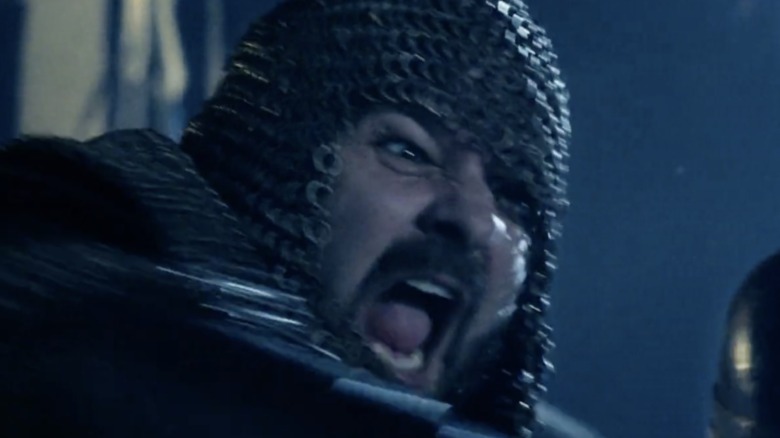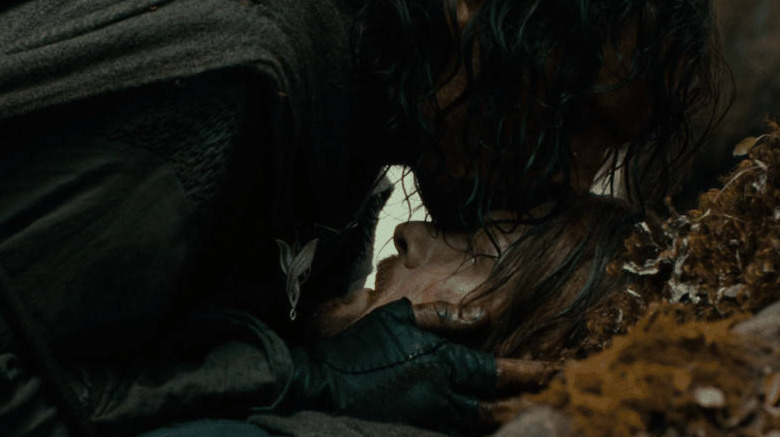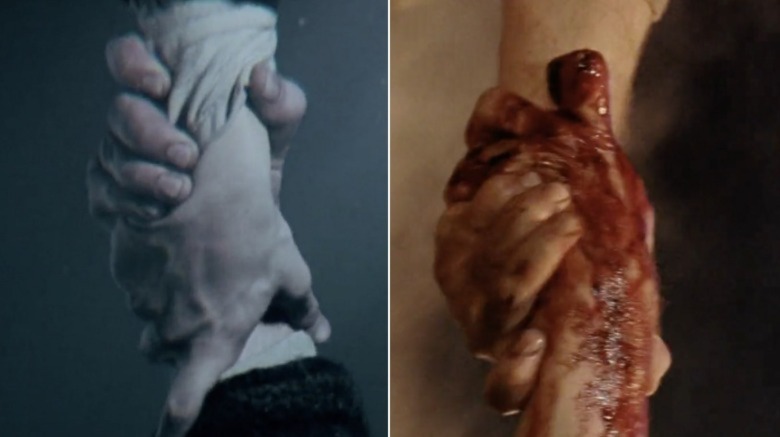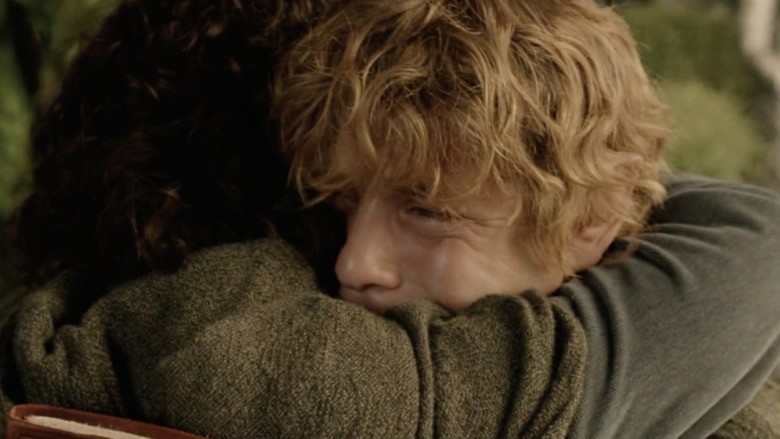Things You Only Notice In Lord Of The Rings After Watching It More Than Once
"The Lord of the Rings" trilogy is, quite simply, one of the greatest cinematic achievements of the 21st Century.
Peter Jackson's fiercely ambitious big screen adaptation of J.R.R. Tolkien's novels changed the game of big-budget fantasy filmmaking. Spanning three films released between 2001 and 2003 — "The Fellowship of the Ring," "The Two Towers," and "The Return of the King" — the trilogy tells of a humble hobbit named Frodo (Elijah Wood) who, along with eight companions, sets out on a journey to destroy the One Ring.
The trilogy is as close to movie magic as you can get. Middle-earth is a richly-rendered world, with a tremendous sense of place and feeling. Repeat viewings reward attentive viewers with all manner of subtle details, from Ngila Dickson and Richard Taylor's delicate costume work to Weta Workshop's intricate weapons design.
So, in that spirit, here are some of the things you may only notice after repeat viewings of "The Lord of the Rings" trilogy.
Arwen inherits Elrond's sword
Swords are a big deal in Middle-earth. Not just because they can cut through Sauron's fingers like butter, but because they tell us a lot about the lineage and character of the swordsman wielding them.
Which brings us to Hadhafang: an arced blade that we see Elrond (Hugo Weaving) sporting on the volcanic slopes of Mount Doom during the prologue of "The Fellowship of the Ring." Attentive viewers will note that this isn't Hadhafang's final appearance. Later in the film, Arwen (Liv Tyler) rushes to Frodo's aid after he is wounded with a Morgul blade on Weathertop, and we see that the sword has passed down from father to daughter. Holding the ailing Frodo close, Arwen brandishes the blade in defiance of the pursuing Ring Wraiths, giving us a clear view of the sword's telltale adornments and memorable curve.
Hadhafang is an invention of Weta Workshop and does not appear in the books. The sword's name, derived from the elvish Sindarin, translates to "throng-cleaver". Per promotional materials, the filmmakers conceived that Hadhafang was originally made for Arwen's grandmother Idril who, like Arwen, loved a mortal man. The translated Sindarin inscription along the blade reads: "this blade is called Hadhafang, a noble defence against the enemy throng for a noble lady." This inscription, naturally, includes a pun that seemingly emphasizes its destined owner: in Sindarin "noble lady" translates to "arwen."
The Eye of Sauron is in the Nazgûl's riding gear
You can fault Sauron for a lot of things: disrupting the peace, trying to take over Middle-earth, you name it. But the Dark Lord has a very keen sense of branding, and you have to respect that. Everything affiliated with Sauron is pitch-black, spiky, and gothic. And amidst all that menacing blackness there is one notable pop of color: an enormous lidless eye, rimmed with fire, situated at the apex of the Dark Lord's towering stronghold, Barad-dûr.
In the films, the Eye of Sauron is effectively the Dark Lord's physical form, which gives the oracular emblem a special kind of importance. It makes sense, then, that the Ringwraiths, the hooded Black Riders bound to the power of the One Ring, would wear a physical symbol of their boss's near-omnipotence. You can catch a glimpse of one such logo in the early half of "The Fellowship of the Ring," when the Nazgûl appear on horseback. If you look closely, you can see that each horse sports a dark, metal breastplate in the shape of the Great Eye. Suspended by a running martingale, each unblinking iron peeper serves as an unsettling reminder of the ever-watchful presence of the Dark Lord.
Viggo Mortensen deflects a dagger with his sword
Of all the tidbits on this list, this is the one you're most likely to miss simply because it happens so dang fast.
During our heroes' confrontation with the Uruk-hai scouts at the end of "The Fellowship of the Ring," Aragorn (Viggo Mortensen) faces off against the brutal Uruk leader, Lurtz (Lawrence Makoare). After massacring Boromir with a bow, Lurtz sets his sights on Aragorn. During their violent confrontation, Lurtz yanks a freshly-planted knife out of his thigh and chucks it in Aragorn's direction (after giving it a big ole' lick, of course). If you blink, you'll miss Mortensen using his sword to legitimately deflect the oncoming blade.
The speed of the blade (or rather: blades) makes the details of this impressive stunt difficult to process. And knowing that the moment is practical and in-camera makes it all the wilder. As Peter Jackson explains in the film's director's commentary, Mortensen pulled off the stunt on the first take: "that was a real knife being thrown, and he literally did bat it away with his sword for real." There are several apocryphal stories circulating online that the whole shot was an accident. But truth is ultimately a heck of a lot more extraordinary than fiction: This was no fluke. Viggo Mortensen is legitimately just that awesome.
Isildur and Boromir have parallel deaths
"The Fellowship of the Ring" offers several memorable reminders of the Ring's tempting power (who can forget that one jump scare where Bilbo becomes a literal monster for a couple of frames?). While all races are susceptible to the One Ring's poisonous influence, as Galadriel reiterates in the first film's prologue: "the hearts of men are easily corrupted."
In "Fellowship," both Isildur (Harry Sinclair) and Boromir (Sean Bean) offer strikingly similar examples of mankind's vulnerability to the One Ring. Both men occupy leadership positions in Gondor, with Isildur ruling jointly alongside his brother Anárion and Boromir set to inherit his father's title of Ruling Steward. Both men fall prey to the Ring's influence and attempt to prevent its destruction: Isildur refuses to destroy the Ring after the War of the Last Alliance and Boromir likewise argues that the Ring should be used as a weapon against Sauron. Indeed, while Aragorn is Isildur's true heir, Boromir embodies much of the same weakness that prevented Isildur from ridding Middle-earth of Sauron all those years ago.
In the end, both men die in almost identical ways: shot with three arrows in an Orc ambush. There is, however, a key difference: unlike Isildur, who remained blinded by the Ring's power until the bitter end, Boromir realizes the effect it has had on him, and fights back. Isildur dies, betrayed, with arrows in his back. Boromir dies defending Merry and Pippin, facing the threat head-on, with arrows in his chest.
All of the Hobbit easter eggs
Back when "The Lord of the Rings" trilogy hit theaters in the early 2000s, "The Hobbit" had yet to properly make its way onto the big screen. Peter Jackson would eventually adapt J.R.R. Tolkien's 310-page novel into its own big-budget trilogy. But for a good little stretch, the events of Bilbo Baggins' adventure only existed in the periphery of the Fellowship's quest. And some of the nods to Tolkien's first book about Middle-earth are a little more subtle, and tribute-like than others.
When Aragorn and the hobbits seek shelter in a fern-covered grove after Frodo is stabbed on Weathertop, three large stone trolls can be seen in the background. These are the same three trolls that menaced (and attempted to eat) Bilbo and company before being turned into stone by the rising sun.
Other missable nods include the corpses of Ori and Balin, two of the dwarves from "The Hobbit," whose dusty remains can be spotted in the tomb in Moria where the Fellowship fight a cave troll. The enormous dragon-shaped firework that causes panic (and then delight) at Bilbo's birthday party feels like a clear nod to Smaug, the treasure-hoarding dragon from "The Hobbit." Why Gandalf would want to re-traumatize Bilbo, however, is a mystery.
Finally, (though there are undoubtedly more easter eggs out there), several chapter titles from "The Hobbit" show up casually as dialogue in "The Lord of the Rings" films, including "I'm not at home" and "riddles in the dark."
After Boromir's death, Aragorn wears his arm braces
Following Boromir's death in "Fellowship of the Ring," Aragorn makes a small, but meaningful, alteration to his armor. During Boromir's funeral, there is a shot of Viggo Mortensen adjusting his leather forearm guards (known as vambraces). On a first viewing, it's easy to miss what he's actually doing: putting on a piece of Boromir's armor.
It is an inherently touching gesture: a physical representation of Boromir's spirit, which will accompany the Fellowship, even in death, all the way to the gates of Mordor. But the vambraces also carry a more explicit narrative implication. Namely: Aragorn's acceptance of the destiny he's been avoiding for over 80 years. The vambraces are the first time we see Aragorn wear Gondor's sigil, a White Tree. In this sense, the wrist guards represent Aragorn's promise to fulfill Boromir's dying wish, to claim his birthright and take responsibility as Gondor's true-born king.
This detail does not occur in the book, nor was it included in the script. In the cast commentary track, Sean Bean stresses that the idea came to Mortensen on-set, the day that they were filming. "It was Viggo's idea," he explains. "I think he wears them for much of the other films. It's almost as though we passed something on to him."
Gandalf carries his pipe in his staff
Gandalf's (Ian McKellen) love of a good smoke is no secret. But this genius detail may have evaded even the most eagle-eyed viewer.
Before his triumphant rebrand as Gandalf the White, Gandalf the Grey appears in far less clean cut attire. His more rugged look includes a spindly, weather-beaten walking stick that doubles as a wand ... and his pipe-holder. Upon closer inspection, Gandalf the Grey's beloved wooden pipe slots snugly into a groove in the top of his staff. You know, for easy access.
You can get a clearer view of the "pipe staff" on Weta Workshop's prop replica shop, where they specify that the "crown of snapped roots" where the pipe rests once held a crystal. Saruman (Christopher Lee) seizes Gandalf's pipe staff during the wizards' confrontation at Orthanc. Given Saruman's condescending remarks about Gandalf's "love of the halflings' leaf” we have to assume the nefarious White Wizard did not appreciate the sneakily concealed paraphernalia.
Gollum's changing pupil size
If you ever need a quick reliable cheat sheet to figuring out when Gollum (Andy Serkis) is Gollum versus when Gollum is Sméagol ... the eyes have it! Or rather, the pupils have it.
Across the trilogy, depending on which persona is "in charge," the size of Gollum's pupils grow and shrink. As the violent, conniving Gollum, the character's pupils are teeny tiny. "Fun" fact, pinpoint pupils are a common symptom of opiate abuse. Considering Gollum's unhealthy obsession and drug-like dependency on the Ring, this is an apt coincidence.
Meanwhile, as the far gentler, affable Sméagol, the creature's pupils are much more dilated. Their larger appearance makes him seem much more sympathetic and less threatening. In short: just as Gollum's vocal inflection, mannerisms, and disposition changes when his personalities shift, so do his pupils.
These pupil changes are consistent throughout "The Two Towers" and "The Return of the King." Which makes sense, because Gollum's appearance in "The Fellowship of the Ring" is more of a brief, shadowy cameo than a proper introduction. All told: Gollum's shifting pupils are just another genius example of all the subtle body language that makes the fully-CGI Gollum (and Sméagol) feel like real, and distinct, characters.
All the Peter Jackson cameos
Peter Jackson is certainly no stranger to sneaking in-front of the camera. Jackson set the precedent with his 1987 feature film debut "Bad Taste" in which (in addition to playing two sizable supporting roles) he appears as the off-screen voice of the local minister. In 1992's "Dead Alive," Jackson makes an appearance as the nerdish undertaker's assistant. In 1994's "Heavenly Creatures" you can spot Jackson as a homeless man, and two years later in "The Frighteners" the director crops up as a menacing, heavily pierced punk.
Much like Alfred Hitchcock before him, Jackson is not one to pass up a director cameo. Which turns spotting his appearances in "The Lord of the Rings" trilogy into something of a "Where's Waldo?" In "The Fellowship of the Ring," Jackson can be spotted as the burping peasant outside the Prancing Pony Inn in Bree, chowing down on an enormous carrot. In "The Two Towers," sharp-eyed viewers can spot Jackson as a spear-chucking soldier of Rohan. Finally, in "The Return of the King," you can catch a quick glimpse of Jackson as one of the Cosairs of Umbar, who, in the extended edition, gets shot by Legolas' accidentally fatal "warning" shot.
While we're here, if you're watching the trilogy and feel like you keep seeing the same children again and again, you're not losing your mind. Jackson and Fran Walsh's two kids, Billy and Katie, appear across all three films as young hobbits listening to Bilbo's stories, Helm's Deep refugees, and frightened children at the besieged Minas Tirith. Turns out, cameo appearances run in the family.
The meaningful musical themes
Howard Shore's trilogy-spanning score for "The Lord of the Rings" is one of the greatest film soundtracks of all time. One of the things that makes Shore's score so great is his intricate use of leitmotifs: short melodic phrases that accompany the appearance of characters, objects, places, and even ideas. In the right hands, leitmotifs can create a complicated symphonic web that, like a wordless opera, mirrors the dramatic connections of the action taking place on-screen.
Doug Adams' 2010 novel "The Music of The Lord of the Rings" identifies over 100 leitmotifs woven across the trilogy. These include themes for the Shire, the Fellowship, and Rohan. There are also less obvious recurring musical themes, like the arpeggio that signals temptation, which appears during Boromir's corruption and forms the basis of Gollum's theme.
It takes repeated viewings (or rather: listenings) to properly appreciate the subtle musical connections that run throughout the trilogy. The same theme that accompanies Boromir's death returns repeatedly when characters recall his sacrifice. When it is applied later to Theoden, it creates a compelling contrast between the two men. Likewise, the slow, dreary piece of music that forms Sméagol's theme incorporates both elements of the temptation theme and the hobbit theme, a combination which aptly summarizes Sméagol's tragic story. You can even catch Sméagol's theme during the scenes where Bilbo adopts Gollum's obsessive mannerisms and covetous attitude towards the Ring.
Sam and Frodo's helping hands
It takes almost nine and a half hours to watch all three theatrical editions of "The Lord of the Rings" films. So, you'd be forgiven for failing to catch the similarities between two shots that take place on opposite ends of the trilogy.
As "The Fellowship of the Ring" draws to a close, Frodo (Elijah Wood), fearing that the Ring will corrupt any and all who get close to him, decides to travel to Mordor alone. Sam (Sean Astin), having none of that, pursues Frodo into the river, where he nearly drowns. Thankfully, Frodo plunges his hand into the water and clasps Sam's wrist. Sam, in turn, seizes Frodo's.
Frodo saves Sam at the beginning of their journey, and at its end, Sam returns the favor. At the end of "The Return of the King," Sam grabs Frodo, pulling him up from the fiery chasm of Mount Doom. The shot perfectly echoes Frodo's earlier gesture: two linked hands, extended vertically, gripped solidly in an unbreakable bond. Side by side, these shots act as a powerful, symmetrical bookend to the pair's adventure. Through the water and fire of Middle-earth, their tidy clothing has been stripped away and their unblemished skin has become blistered and bloody. Much has changed, but to the bitter end, their love and loyalty for each other remains intact and unbroken.
Frodo left Middle-earth so that Sam could live a normal life
At the end of "The Return of the King," Frodo literally sails off into the sunset. Along with Bilbo, Gandalf, and several elves, Frodo (Elijah Wood) is permitted to travel to Valinor, the Undying Lands, where he intends to remain for the rest of his life. When Sam (Sean Astin), distressed at the thought of losing his friend, asks Frodo why he is leaving, Frodo explains that his departure is the only way he can recover from his contact with the One Ring, as well as the still-festering wound where the Morgul blade pierced his chest on Weathertop.
Frodo's sacrifice is certainly the main reason why he is permitted to travel to a place typically reserved for immortal beings. But after multiple viewings, another, more personal motive emerges: Frodo's emotional and physical trauma from his journey have made it impossible for him to return to normal life in the same way that Sam has. Where Sam has moved on from their adventures, getting married and having a young daughter, Frodo is unable to escape the lasting effects of being a ring-bearer. There is an implication, however subtle, that Frodo intends for his departure to release Sam from that chapter of their lives, so he can focus on his new domestic future in the Shire.
